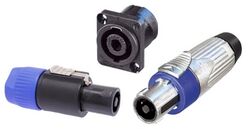Engineering:Speakon connector

The Speakon (stylized speakON) is a trademarked name for an electrical connector,[2] originally manufactured by Neutrik, mostly used in professional audio systems for connecting loudspeakers to amplifiers. Other manufacturers make compatible products,[3] often under the name "speaker twist connector".
Speakon connectors are rated for at least 30 A RMS continuous current,[4] higher than 1/4-inch TS phone connectors, two-pole twist lock, and XLR connectors for loudspeakers.[5]
Design
A Speakon connector is designed with a locking system that may be designed for soldered or screw-type connections. Line connectors (male) mate with (female) panel connectors and typically a cable will have identical connectors at both ends. If it is needed to join cables, a coupler can be used (which essentially consists of two panel connectors mounted on the ends of a plastic tube). The design was conceived in 1987.[6]
Speakon connectors are designed to be unambiguous in their use in speaker cables. With 1/4" speaker jacks and XLR connections, it is possible for users to erroneously use low-current shielded microphone or instrument cables in a high-current speaker application. Speakon cables are intended solely for use in high current audio applications.
Speakon connectors arrange their contacts in two concentric rings, with the inner contacts named +1, +2, etc. and the outer contacts connectors (in the four-pole and eight-pole version only) named −1, −2, etc.[7] The phase convention is that positive voltage on the + contact causes air to be pushed away from the speaker.
Speakon connectors are made in two, four and eight-pole configurations. The two-pole line connector will mate with the four-pole panel connector, connecting to +1 and −1; but the reverse combination will not work. The eight-pole connector is physically larger to accommodate the extra poles. The four-pole connector is the most common at least from the availability of ready-made leads, as it allows for things like bi-amping (two of the four connections for the higher-frequency signal, with the other two for the lower-frequency signal) without two separate cables. Similarly, the eight-pole connector could be used for tri-amping (two poles each for low, mid and high frequencies with two unused), or quad-amping (two poles each for high, mid, low and sub).
Another use for the four-pole cable is to carry two channels of amplified signal from an amplifier to a pair of loudspeakers using a 'combiner' Y-lead connected to the two output channels, and a 'splitter' Y-lead to feed the loudspeakers. The 'combiner' and 'splitter' Y-leads are the same: two two-pole connectors on one end, connected to the ±1 and ±2 pins, respectively, of a four-pole line connector at the other end.[8] Some amplifiers and mixer-amplifiers are configured to do this without the need for a 'combiner'.
Also available are 2-pole "combo" receptacles that can also accept 4-pole cables and 1/4″ phone plugs.
In 2019 the manufacturer introduced the STX series which included male line connectors and female panel connectors.[6]
See also
- PowerCon
References
- ↑ "NL2FX drawing". Neutrik. http://www.neutrik.com/zoolu-website/media/download/11984/Drawing+NL2FX.
- ↑ "Speakon trademark page". Neutrik. http://www.neutrik.com/en/legal-notices.
- ↑ E.g. Switchcraft HPC (High Power Connectors) Series
- ↑ Neutrik. "NL4FC" (in en). https://www.neutrik.com/en/product/nl4fc.
- ↑ "Speakon Speaker Connectors - The Basics". https://gollihurmusic.com/speakon-speaker-connectors-what-are-they-and-why-are-they-used/.
- ↑ 6.0 6.1 "speakON® Connectors". https://www.neutrik.com/media/10094/download/product-guide---section-loundspeaker-connectors.pdf%3Fv%3D1.
- ↑ "Electronics 2000 | Pin-outs | Speakon Connectors". https://www.electronics2000.co.uk/pin-out/speakon.php.
- ↑ "MX21's bi-amp information: custom speakon cable". http://greenboy.us/fEARful/biamp.htm#custom_cable.
External links
 |


